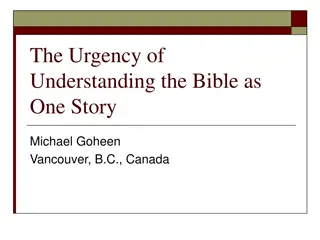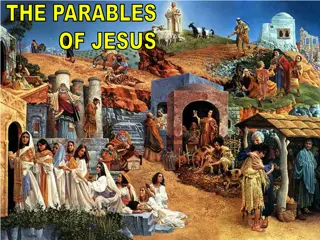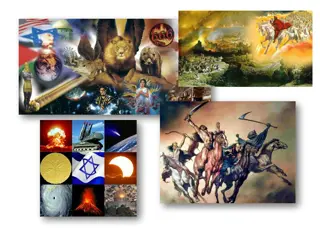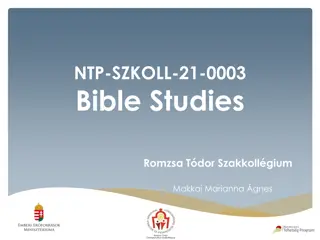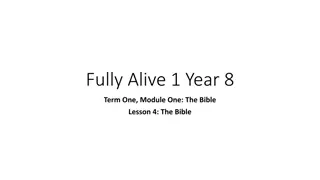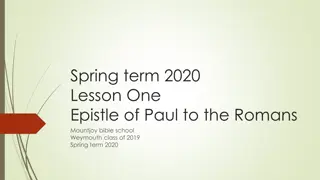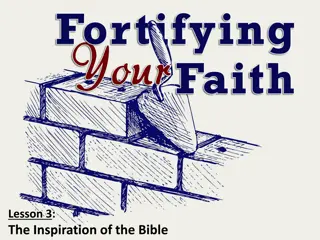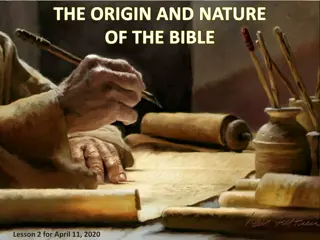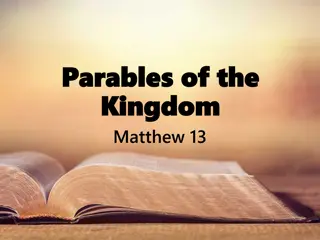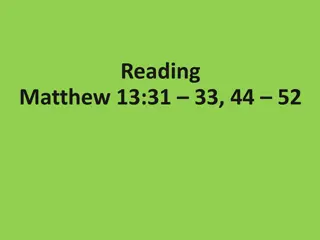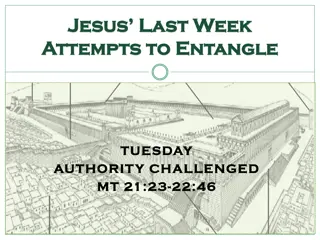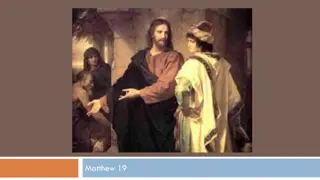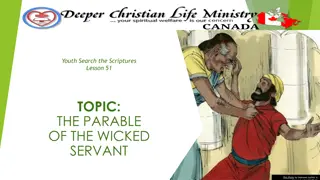Understanding Parables in the Bible
An exploration of parables in the Bible, delving into the Hebrew and Greek words for parable, examples from Job and Matthew, and the different English words used for "parable." The significance of parables in conveying general truths and teachings is highlighted through references from the Old and New Testaments.
Download Presentation

Please find below an Image/Link to download the presentation.
The content on the website is provided AS IS for your information and personal use only. It may not be sold, licensed, or shared on other websites without obtaining consent from the author. Download presentation by click this link. If you encounter any issues during the download, it is possible that the publisher has removed the file from their server.
E N D
Presentation Transcript
PARABLES Of the Bible
DEFINING A PARABLE The Hebrew word for parable: MASHAL (MAWSHAWL) Simile; poem; proverb; adage a short statement expressing a general truth. A saying usually of metaphorical nature. - The word occurs approx. 39 times in the O.T. - EXAMPLE: Job 27:1; 29:1
Job 27:1 Moreover Job continued his parable, and said, Job 29:1 Moreover Job continued his parable, and said,
English Words used in KJV for MASHAL proverb (19 times) parable (18 times) byword (1 time) like (1 time)
DEFINING A PARABLE One Greek word for parable: PARABOLE (PARABOLAY) Simile; proverb; adage; comparison; placing beside or together A narrative usually of fictitious nature. - The word occurs approx. 50 times in the N.T. - EXAMPLE: Matt. 15:15; 24:32
Matt. 15:15 Then answered Peter and said unto him, Declare unto us this parable. Mt 24:32 Now learn a parable of the fig tree; When his branch is yet tender, and putteth forth leaves, ye know that summer is nigh:
English Words used in KJV for PARABOLE proverb parable figure comparison (1 time) (1 time) (46 times) (2 times)
DEFINING A PARABLE Another Greek word for parable: PAROIMIA (PAR-OY-MEE-AH) Proverb; adage An illustration usually of fictitious nature. - The word occurs approx. 4 times in the N.T. - EXAMPLE: John 10:6; 16:25
John 10:6 This parable spake Jesus unto them: but they understood not what things they were which he spake unto them. John 16:25 These things have I spoken unto you in proverbs: but the time cometh, when I shall no more speak unto you in proverbs, but I shall shew you plainly of the Father.
English Words used in KJV for PAROIMIA proverb parable (3 times) (1 time)
PARABLES Of the Bible
WORKING DEFINITION A parable is an utterance that involves a comparison
WORKING DEFINITION A parable is an illustration of one subject by another
WORKING DEFINITION A parable is a symbolic story, saying or narrative of common life that conveys a moral or a lesson
INTERPRETING PARABLES REMEMBER that parables sometimes denote: a true history, or an illustrative sketch from nature; sometimes a proverb or adage; a truth darkly or figuratively expressed; a type; or a figure.
INTERPRETING PARABLES In the interpretation of a parable, its primary truth, main scope and lesson are chiefly to be considered. The minute particulars and details of the parable are not the main focus, but the meaning behind it.
INTERPRETING PARABLES The THREE main questions to ask are: (1) What is the parable saying? (2) What did it mean then? (3) What is applicable to my life?
WHY SPEAK IN PARABLES? PARABLES ARE JUST ANOTHER WAY OF SAYING THINGS THAT YOU EXPECT THOSE WHO NEED TO KNOW, WILL KNOW; & THOSE WHO DO NOT WANT TO KNOW; WILL NOT KNOW (MATTHEW 13:10-16)
A Familiar O.T. Parable The rich man, the poor man & the little lamb (2 Samuel 12:1-9)
MAIN CHARACTERS The rich man: Who does he represent? DAVID
MAIN CHARACTERS The poor man: Who does he represent? URIAH
MAIN CHARACTERS The ewe lamb: Who does the lamb represent? BATHSHEBA
PARABLE MESSAGE To whom was the parable directed? What was the parable depicting? What was the lesson or moral of the parable?
A Familiar N.T. Parable THE SOWER (Matthew 13:1-23)
MAIN CHARACTER The sower: Who does the sower represent? EVANGELIST, PREACHER, WITNESS, BELIEVER
KEY ELEMENTS The seed: What does the seed represent? THE WORD, THE GOSPEL
KEY ELEMENTS The way side: What does it represent & what happened? A person who hears but does not understand and is then distracted by the devil
KEY ELEMENTS The stony places: What does it represent & what happened? A person who hears, understands & receives message but was not rooted & grounded
KEY ELEMENTS The thorny places: What does it represent & what happened? A person who hears, understands & receives message but was overwhelmed by circumstances & falls away
KEY ELEMENTS The good ground: What does it represent & what happened? A person who hears, understands & receives message & is a doer of the word, grows by it & produces more fruit.
PARABLE MESSAGE To whom was the parable directed? MULTITUDES (EVERYONE)
PARABLE MESSAGE What was the parable depicting? The various responses & results than can occur when the word is preached.
PARABLE MESSAGE What was the lesson or moral of the parable? Spread the Word (gospel) and it will accomplish what it wills. The results will speak for themselves.
PARABLE #3 THE TREES (Judges 9:1-21)
KEYNOTE SPEAKER Who was the speaker of the parable? JOTHAM (Judges 9:7)
KEYNOTE SPEAKER Who was Jotham? The youngest son of Jerubbaal & brother of Abimelech (Judges 9:1-5)
AUDIENCE To whom was the parable directed? THE MEN OF SHECHEM (Judges 9:7)
KEY ELEMENTS The trees: Who does the trees represent? THE MEN OF ISRAEL (Judges 8:22-23)
KEY ELEMENTS The olive tree: Who does the olive tree represent? GIDEON (Judges 8:22-23)
KEY ELEMENTS How does Gideon fit into this picture? Gideon is Jerubbaal!! (Judges 7:1; 8:35)
KEY ELEMENTS How does Gideon relate to the other characters? Gideon is the father of Jotham & Abimelech (Judges 8:30-31; 9:1;5)
KEY ELEMENTS The fig tree: Who does the fig tree represent? GIDEON S SON (Judges 8:22-23)
KEY ELEMENTS The vine: Who does the vine represent? GIDEON S GRANDSON (Judges 8:22-23)
KEY ELEMENTS The bramble: Who does the bramble represent? ABIMELECH (Judges 9:16-18)
KEY ELEMENTS Cedars of Lebanon: Who does the cedars represent? THE MEN OF SHECHEM (Judges 9:15; 20)
INTERPRETATIONS Olive tree s response (vs.9): Shall I leave the sweet, safe, quiet, useful pursuits and my significant role, for the sake of becoming a ruler? No thank you!
INTERPRETATIONS Olive tree: This tree was the most useful of all the trees in the forest. A tree yielding oil, used not only in food, but in various ways in the worship of God and in the consecration of men to public office such as kings, and priests, and prophets.
INTERPRETATIONS Fig tree s response (vs.11): Shall I leave my productive service that is important to others & myself to rule people? No thank you!
INTERPRETATIONS Fig tree: The fruit of this tree is the sweetest or most luscious of all fruits. A full-ripe fig, has an indescribable sweetness; so much so that it is almost impossible to eat it, till a considerable time after it is gathered from the trees, and has gone through an artificial preparation.
INTERPRETATIONS Vine s response (vs.13): Shall I forsake my vital contribution, which is appreciated by God & men, to rule over people? No thank you!


